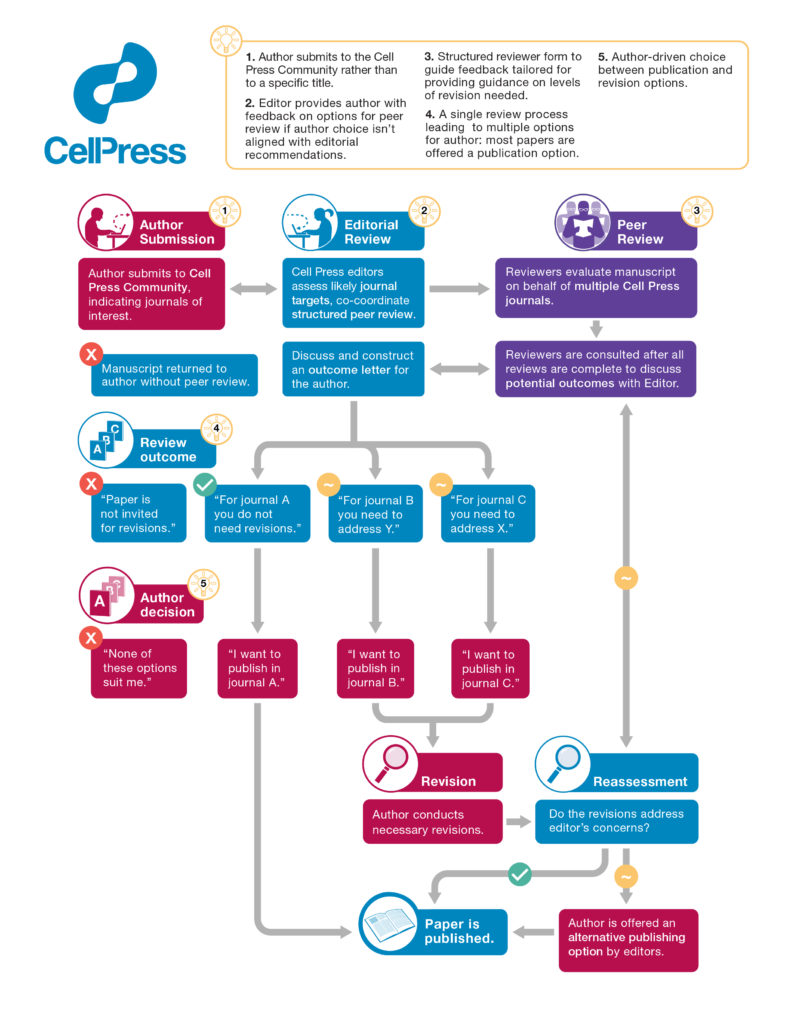Cell Press recently announced a new initiative called Community Review. The initiative tackles the core inefficiency of the current peer review system: articles often have to be reviewed at multiple journals before finding the right place where they ‘fit’. This wastes reviewer and editorial effort at the rejecting journals and introduces major delays to the publication process.
Community Review has some similarities with the concept of independent peer review, as peer review is taking place outside the confines of a single journal and ‘fit’ for different Cell Press journals is assessed in parallel. To learn more about this initiative I contacted Deborah Sweet (Vice President of Editorial at Cell Press). Our conversation is below.

What’s the motivation behind creating Community Review?
Put simply, we would like to make the publishing process work better for everyone involved. We see and hear a lot of frustration from authors, but also from reviewers and editors, about the traditional sequential approach to journal publishing where authors submit to one journal and then go to another one if they aren’t successful at the first. Authors spend more time than they need to getting from submission to publication, often without really very much guidance about how to navigate that path effectively, and reviewers and editors do more work than they need to by repeating the same assessment at different journals. We hope the Community Review system will be a way to help authors, reviewers, and editors, collaborate together to get papers published in a more efficient and effective way.
How did you first come up with the idea?
We developed this concept at a retreat we held for our Editors-in-Chief back in the spring of 2019. For that meeting, we had asked small groups to work ahead of time on ideas about how we could organize our activities differently to be more effective, and one of the teams worked on this basic idea. After the team presentations we voted and this idea was by far the most popular of the ones we came up with. We all got very inspired, and decided we wanted to work on making it a reality. It took us a while to go from concept to functional system, but now we are here and excited to be testing it out.
Could you give us a quick overview of how it works?
In essence, the idea is to take papers through a single review process and then offer the authors a range of options for how they move to publication based on the outcome of the review process. Some of these options might involve doing revisions, others might not, and the authors can choose how to proceed based on their particular situation and the feedback they get.
More specifically, authors submit to the Community Review system, and at the outset indicate which journals they are interested in having their paper considered for. A dedicated Community Editor then does an initial review of the paper and consults with expert editors at the relevant individual journals. If we find there is a mismatch between the authors’ journal choices and where the editors see the best fit, we will discuss that feedback with the authors before proceeding to review. For the review process itself, there is close discussion between the journal representatives and the Community Editor regarding inviting appropriate reviewers for the paper and journals involved. Once the review process is complete, the Community Editor consults again with the journal representatives to formulate a decision letter for the author that outlines their options in terms of the type of revisions, if any, the different journals would be looking for to consider a revised paper. Then there is a discussion with the author to help them formulate a plan for revision based on their favored option. After the revisions (if needed) are complete, the author resubmits and (assuming the revisions are sufficient) is then published in the journal they chose to aim for.
There are of course a lot of nuances within this process, including cross-consultation among the reviewers, discussion with the editors, and the possibility of a change in plan if revisions don’t pan out entirely as anticipated, and anyone who has participated in publishing processes knows that many variations could in principle come up and need working around. But hopefully that clarifies the basic idea.
The graphic we included on our website illustrates the overall flow of the process and highlights the key steps as well.

Will the Cell Press journal typically begin its own new round of peer review once the manuscript is submitted there?
No, that is not the idea at all. The review process happens in the Community Review system in consultation with the editors at the individual journals. By the time the paper transfers over to a specific journal it should be already going through the final steps needed before being accepted for publication.
The authors provide a list of Cell Press journals that they think their article could be published in. Is there a limit on how many they can choose? Could they include a journal that isn’t in the Cell Press family?
Currently authors can choose as many Cell Press life science journals as they want, there is no limit. We are keeping it just to Cell Press at the moment, though, because the current setup of the system relies a lot on close and efficient cooperation between our in-house professional editors. It would in principle be possible to include external academic editors too, but that would require adjustments and we don’t have plans to expand in that direction at this time, especially as we are still in the process of developing the system and testing it out.
Is the journal list shown to the reviewers, and (if so) do the reviewers comment on whether they think the manuscript is suitable for each journal?
Yes, the reviewers do know which journals the authors have expressed interest in. We have a structured reviewer form to ask for specific comments primarily aimed at understanding what the reviewers see as the strengths and limitations of the work, so the authors get clear feedback and the editors can make an informed assessment of whether it seems a good fit for a given journal. We do also ask the reviewers for their opinion on this point, just as we do in the more traditional system, and that too feeds into the decision process.
How are the Community Editors selected? It sounds like they’ll have to be an expert in every field that Cell Press covers.
The Community Editors are trained Cell Press editors so they are already accustomed to reading broadly and assessing a wide range of different studies. However, it’s important to remember that the whole process is done in close consultation with Scientific Editors at the individual journals that the authors are interested in, plus of course the external expert reviewers, so the Community Editors are tapping into all of that expertise to help them guide the authors and the paper through the review process.
Do the editors at the participating journals have the right to refuse articles that the Community Editor thinks are appropriate?
The editorial and publishing criteria for our different journals are not changing because we are putting this Community Review process in place. So, the expectations for publication in a given journal will remain the same, and if the editors of that journal don’t think a submitted paper is a good fit, then they would not proceed with publishing it. The Community Editor is coordinating the process based on feedback from editors at the individual journals, so the decision about whether a given paper is a good fit or not comes primarily from the editors who are dedicated to that journal, not the Community Editor.
If the Community Editor decides that the article is suitable for two journals, could it potentially be published in both? (It would then be able to reach both audiences, which is really important for multidisciplinary studies).
We do not plan to publish research papers in two journals at the same time. We would approach a situation like this by giving the authors a choice of which journal to proceed with, depending on where they see the best fit and likely audience. I think one of the strengths of the Community Review process is that it would also allow authors to make a decision about what types of revision to focus on depending on which journal they are aiming to ultimately publish in, because different journals can focus on different aspects of the paper. Your point about audience awareness is a good one, though. We hope that as part of the revision plan discussion, the Community Editor will be able to work with the authors to help them think about the most appropriate audience and fit. In addition, we do have a number of broad scope journals, which of course have wide audiences across many different fields, so authors have those as options as well if they are concerned about this issue.
What are your metrics for success in this pilot? If the pilot is successful, could this become the main route for submitting to Cell journals?
Our main goal is to find a way to help more of the authors who submit to us to get their paper published in an efficient and constructive way. So, we are hoping to see both more ultimate acceptance decisions and a faster overall time to publication compared to the traditional process (including potentially multiple sequential submissions to different journals). We also hope to find that this process will mean less work for reviewers (fewer reviews to do overall). We will of course also gather feedback from authors and reviewers who participate in the pilot to ask them about their perspective and whether they find this system an improvement relative to the traditional approach. We’ll do that in an ongoing way and are hoping to use that feedback continuously to help us refine and develop the system. We also see opportunities for layering additional options like transparent peer review and portable peer review on top of this system in the future, but those would be add-ons once we have the basic system working well. I’m not sure at this point whether Community Review will become the main route for submission to Cell Press – we will have to see how popular it turns out to be! But at a minimum I would hope we’d continue to offer it as an option for authors who are interested in this type of multi-journal consideration process.
Lastly, the pilot raises some very interesting questions about what constitutes a ‘brand’ in scholarly publishing. Traditionally, the focus has always been on the journal, with the publisher in the background. The Community Review approach makes ‘Cell Press’ the brand, that the authors are hoping to publish in one or more of your journals. Cell Press has a fairly discrete audience, but will other publishers be able to replicate this ‘publisher first branding? Will people one day say ‘I can really see this manuscript in an Elsevier journal’?
Those are indeed interesting questions! We are thinking of the Cell Press journal family as the “Community” that the system is named after, and I think other publishers would in principle be able to replicate this type of system if they have a family of journals that they could set up to work together in this way. There are elements of the characteristic Cell Press experience that I think authors know they can expect from all of our journals and from our Community Review system as well, including fast and fair consideration, thoughtful and engaged editors, and high-quality production of the final article. So in that respect at least it is an extension of the Cell Press brand.
But we’re not intending that Community Review will usurp the idea of publishing in a journal – ultimately that is still what will happen to all the papers. They will appear in a specific journal in the same way as they do now. Based on what we hear from scientists, they still place a lot of value on publishing in individual journals, and I at least don’t see that changing in the foreseeable future. So, really, the Community Review process is just designed to help make getting to that point more efficient and straightforward for everyone who contributes. If that turns out to be the case then we will definitely view it as being a success.
Discussion
12 Thoughts on "Parallel Peer Review at Cell Press: An Interview with Deborah Sweet"
Let’s be clear — while there are some efficiencies created here for authors (at least those who will be satisfied with cascading their articles within one company’s titles), there’s also a strong business strategy behind these sorts of arrangements. In the brick and mortar world, once a customer comes into the shop, the goal is not to let them leave without buying something. Here, once an author has submitted a paper to a publisher, the goal is to keep their paper in house, and, assuming a shift to author-pays open access, keep their APC in house. Given the high rejection rates of most Cell branded journals, this would appear to be a feeding mechanism for Cell’s megajournal, Cell Reports, which needs a significant quantity of papers to succeed in a competitive megajournal market.
The other interesting thing this strategy brings up is that one must come up with an internal ranking system for all of your journals. Not good enough for Title A, but good enough for Title B (and probably too good for Title C). There are going to be some bruised egos when an editor is informed of where their journal sits in the overall ranking, and this is going to be a non-starter for publishers to implement with research society owned titles, as it is unlikely they’re going to accept being told they are lesser to anyone else’s journals. This is likely why Cell’s partner journals are excluded from this program.
Hi David – thanks for the comment and feedback.
We did come at this with a view to increasing the number of overall accceptance decisions, but with the authors in mind. These aren’t real numbers, but essentially our early discussion was “how can we flip the situation for our authors so instead of 80% of our decisions being some kind of rejection, 80% of them are an offer to publish the paper”. It’s so much nicer for authors to enter into a review process thinking they will get constructive options out of it, whether or not they choose to take them up.
And to your second point, as I said the reason for keeping it to in-house edited journals is because of the high degree of cooperation required between editors. We also have to think about confidentiality, and be very careful about introducing external academics into our network for access to our journal databases, reviewer names etc. I imagine it be possible to incorporate journals run by academic editors with some changes, but it would take adaptation of the current approach and at this time, while we are still figuring out whether it really does work in the way that we intend, that seems like a complication that it is best to avoid.
Hope that clarifies.
At Axios we consistently hit an 85% acceptance rate once the article got to a journal, with about half of those not going back out for review. Those figures (15% re-reviewed and rejected, 40% re-reviewed and accepted after further revision, and 45% immediately accepted) match the decision ratios for revisions fairly closely, at least at journals I’ve been involved with.
This is exactly right. The alleged benefits to authors are irrelevant if they don’t further the business interests of the journal publisher. It is misleading (and bad economics) to pretend otherwise. Also, authors are not customers except for Gold OA. The customer is the person who writes the check. Stakeholders are another matter and relevant for a discussion of brand management, aka marketing.
I couldn’t agree more with your comments Joe. The ultimate goal is to capture market share in subject specific fields. Sure there may be service like author benefits but the reality is indeed to keep the articles within one publisher. The market share is not just about the authors but also the data in the articles, and as a next step the uderlying data behind the article. Cascading will only be possible if the range of journals to “choose” from is wide enough to make that into a real option for these authors. But it seems that most if not all large publishing houses are the ones benfitting the most. Either in OA revenues, existing library licenses and in future AI derived analyses.
Chris Kluiters
Surely Heliyon is their megajournal? But yes, it’d be interesting to see an actual formal ranking, for some journals at least; for instance, and sticking with Cell Press, I guess that Cell Reports is meant to be a more selective journal than iScience, and that therefore it should potentially be possible to have a paper rejected from Cell Reports but published in iScience. However, this is all inferred on my part, and perhaps they have a different opinion internally.
You’re right — I had thought that Heliyon was under the Elsevier umbrella, rather than specific to Cell Press, but it does indeed appear to be listed under Cell Press. So that would be the bottom rung of the ladder.
And yes, I agree that it would be interesting to see how things have been tiered overall, and how those rankings went over with the journal editors.
I think if something is both good for customers (= authors) and good for the journals that makes it a sound idea. If authors don’t like what they’re offered then they can alway go elsewhere.
With respect to your second point, we dealt with this at Axios by never telling the individual journals how the authors had ranked them – they were just approached individually, and only ever with the comments related to that title. To preserve Cell Press EIC’s self esteem I expect that the Editors at Community Review will take the same approach.
In this kind of system I can see an incentive existing for authors, especially those who need to get published quickly, to go with the journal that does not require any revisions. This may be good for the authors in the short term but not good for the field in the long term.
Thanks for this comment Sandy. It’s more a question of how much the authors want to develop the paper. Of course for any journal the findings and conclusions need to be supported by the experiments being presented, and if they are not then the authors would need to make revisions either to the experiments or to the conclusions. But if, for example, to develop the story to a point at which the paper would be a good fit for journal A the authors would need to spend 6 mos to a year on new experiments, whereas for journal B a more limited set of conclusions that are supported by the current data are fine, they might choose the journal B route. That doesn’t seem like a problem to me for the overall progress of science.
To David’s point “Not good enough for Title A, but good enough for Title B (and probably too good for Title C)…” what does “good enough” mean? Isn’t it possible that journals A, B, and C have different requirements in scope, structure, and conditions particular to a field — in addition to “good science” — but with overlapping audiences (life sciences is a big umbrella)? I don’t think its always good, better, best. Your comment is the same reason some of us dislike the word “cascade.”
I submitted one review to TiPS in 2017 it took 8 months to collect review reports after two revisions..and send the decision after new editor appointed in 2018 the editor was not satisfied the reviewers positive..they pull back agin to re review process…they sends the negative reviewers and killed that manuscript finally after waiting 1 year. This is the reality of editors at TiPS. I emailed every thing to Debora..she was convinced to we go this our editor decision is fairly made..


